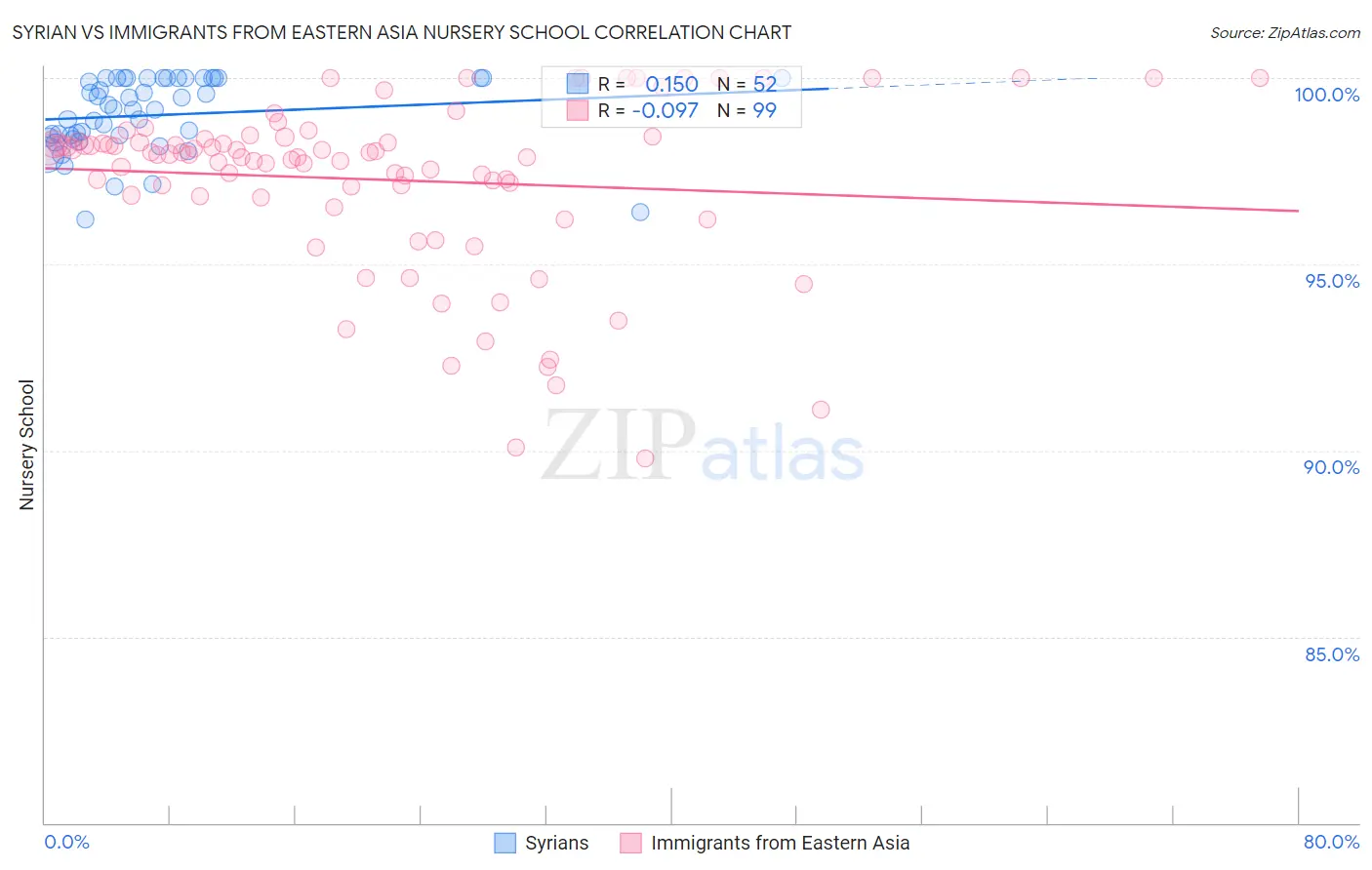Syrian vs Immigrants from Eastern Asia Nursery School
COMPARE
Syrian
Immigrants from Eastern Asia
Nursery School
Nursery School Comparison
Syrians
Immigrants from Eastern Asia
98.2%
NURSERY SCHOOL
93.9/ 100
METRIC RATING
123rd/ 347
METRIC RANK
97.7%
NURSERY SCHOOL
1.6/ 100
METRIC RATING
239th/ 347
METRIC RANK
Syrian vs Immigrants from Eastern Asia Nursery School Correlation Chart
The statistical analysis conducted on geographies consisting of 266,306,307 people shows a poor positive correlation between the proportion of Syrians and percentage of population with at least nursery school education in the United States with a correlation coefficient (R) of 0.150 and weighted average of 98.2%. Similarly, the statistical analysis conducted on geographies consisting of 499,865,893 people shows a slight negative correlation between the proportion of Immigrants from Eastern Asia and percentage of population with at least nursery school education in the United States with a correlation coefficient (R) of -0.097 and weighted average of 97.7%, a difference of 0.52%.

Nursery School Correlation Summary
| Measurement | Syrian | Immigrants from Eastern Asia |
| Minimum | 96.2% | 89.8% |
| Maximum | 100.0% | 100.0% |
| Range | 3.8% | 10.2% |
| Mean | 99.0% | 97.3% |
| Median | 99.2% | 98.0% |
| Interquartile 25% (IQ1) | 98.4% | 96.8% |
| Interquartile 75% (IQ3) | 100.0% | 98.4% |
| Interquartile Range (IQR) | 1.6% | 1.5% |
| Standard Deviation (Sample) | 0.99% | 2.3% |
| Standard Deviation (Population) | 0.98% | 2.3% |
Similar Demographics by Nursery School
Demographics Similar to Syrians by Nursery School
In terms of nursery school, the demographic groups most similar to Syrians are Immigrants from Zimbabwe (98.2%, a difference of 0.0%), Immigrants from Japan (98.2%, a difference of 0.0%), Lebanese (98.2%, a difference of 0.0%), Iroquois (98.2%, a difference of 0.0%), and Menominee (98.2%, a difference of 0.0%).
| Demographics | Rating | Rank | Nursery School |
| Spanish | 95.8 /100 | #116 | Exceptional 98.2% |
| Immigrants | France | 95.6 /100 | #117 | Exceptional 98.2% |
| Yugoslavians | 95.4 /100 | #118 | Exceptional 98.2% |
| Thais | 95.0 /100 | #119 | Exceptional 98.2% |
| Okinawans | 94.5 /100 | #120 | Exceptional 98.2% |
| Immigrants | Zimbabwe | 94.2 /100 | #121 | Exceptional 98.2% |
| Immigrants | Japan | 94.0 /100 | #122 | Exceptional 98.2% |
| Syrians | 93.9 /100 | #123 | Exceptional 98.2% |
| Lebanese | 93.8 /100 | #124 | Exceptional 98.2% |
| Iroquois | 93.7 /100 | #125 | Exceptional 98.2% |
| Menominee | 93.6 /100 | #126 | Exceptional 98.2% |
| Immigrants | Saudi Arabia | 93.4 /100 | #127 | Exceptional 98.2% |
| Immigrants | Serbia | 92.4 /100 | #128 | Exceptional 98.2% |
| Cambodians | 91.4 /100 | #129 | Exceptional 98.2% |
| Immigrants | Croatia | 91.4 /100 | #130 | Exceptional 98.2% |
Demographics Similar to Immigrants from Eastern Asia by Nursery School
In terms of nursery school, the demographic groups most similar to Immigrants from Eastern Asia are Nigerian (97.7%, a difference of 0.010%), Korean (97.7%, a difference of 0.010%), U.S. Virgin Islander (97.7%, a difference of 0.020%), Colombian (97.7%, a difference of 0.020%), and Immigrants from Pakistan (97.7%, a difference of 0.020%).
| Demographics | Rating | Rank | Nursery School |
| Immigrants | Uruguay | 2.3 /100 | #232 | Tragic 97.7% |
| U.S. Virgin Islanders | 2.1 /100 | #233 | Tragic 97.7% |
| Colombians | 2.1 /100 | #234 | Tragic 97.7% |
| Immigrants | Pakistan | 2.1 /100 | #235 | Tragic 97.7% |
| Immigrants | Malaysia | 1.9 /100 | #236 | Tragic 97.7% |
| Immigrants | Western Asia | 1.9 /100 | #237 | Tragic 97.7% |
| Nigerians | 1.7 /100 | #238 | Tragic 97.7% |
| Immigrants | Eastern Asia | 1.6 /100 | #239 | Tragic 97.7% |
| Koreans | 1.4 /100 | #240 | Tragic 97.7% |
| Immigrants | Indonesia | 1.1 /100 | #241 | Tragic 97.7% |
| Liberians | 1.1 /100 | #242 | Tragic 97.7% |
| Asians | 1.1 /100 | #243 | Tragic 97.6% |
| South Americans | 1.0 /100 | #244 | Tragic 97.6% |
| Bolivians | 1.0 /100 | #245 | Tragic 97.6% |
| Peruvians | 1.0 /100 | #246 | Tragic 97.6% |